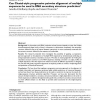184 search results - page 13 / 37 » A branch-and-cut algorithm for multiple sequence alignment |
BMCBI
2007
13 years 7 months ago
2007
Background: By virtue of their shared ancestry, homologous sequences are similar in their structure and function. Consequently, multiple sequence alignments are routinely used to ...
JCB
2000
13 years 7 months ago
2000
Multiple sequence alignments (MSAs) are frequently used in the study of families of protein sequences or DNA/RNA sequences. They are a fundamental tool for the understanding of th...
BMCBI
2007
13 years 7 months ago
2007
Background: In ribonucleic acid (RNA) molecules whose function depends on their final, folded three-dimensional shape (such as those in ribosomes or spliceosome complexes), the se...
NAR
2010
13 years 2 months ago
2010
Evaluating the accuracy of multiple sequence alignment (MSA) is critical for virtually every comparative sequence analysis that uses an MSA as input. Here we present the GUIDANCE ...
EVOW
2010
Springer
13 years 11 months ago
2010
Springer
A challenging problem in bioinformatics is the detection of residues that account for protein function specificity, not only in order to gain deeper insight in the nature of functi...

